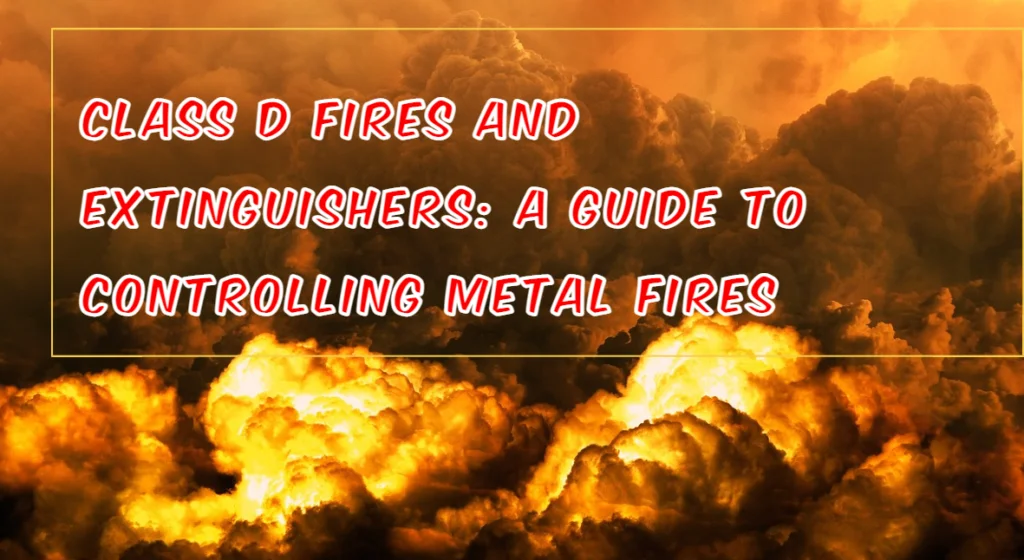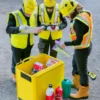
1. Introduction
When it comes to fire safety, it’s important to understand the different types of fires and how to put them out safely and effectively. One type of fire that requires special attention is the Class D fire, which involves burning metals such as lithium, magnesium, steel, and aluminum. Unlike other types of fires, Class D fires require specific types of extinguishing agents to put them out, as water can actually make them worse.
2. Causes of Class D Fires
Class D fires are caused by the ignition of combustible metals. These metals react with oxygen in the air and can produce intense heat and flame. In addition to burning hotter than other types of fires, Class D fires can also be difficult to put out because they can burn at high temperatures even when not in contact with the source of ignition.
One of the biggest challenges with Class D fires is that many common extinguishing agents, such as water, can actually make the fire worse. When water is applied to a Class D fire, it reacts with the metal and produces hydrogen gas, which can then ignite and cause an explosion. Therefore, it’s crucial to use the correct type of extinguishing agent for Class D fires to avoid making the situation worse.
Another factor that makes Class D fires dangerous is the amount of energy that is released during the reaction between the metal and the extinguishing agent. For example, when sodium chloride is used to extinguish a burning metal, it dissipates heat and produces a salt crust over the metal, which helps to prevent re-ignition. However, the reaction between the sodium chloride and the metal can also release a large amount of energy, which can create additional hazards.
In addition to the types of metals involved, other factors that can contribute to Class D fires include poor ventilation, improper storage of flammable materials, and the presence of other combustible materials in the vicinity. By understanding the causes and risks of Class D fires, you can take steps to prevent them from occurring and ensure that you have the right type of extinguishing agent on hand in case of an emergency.
Overall, Class D fires pose unique challenges that require specific knowledge and tools to effectively extinguish. By taking the time to understand the causes of these fires and the proper procedures for extinguishing them, you can help to minimize the risk of injury, property damage, and other hazards associated with these types of fires.
3. Class D Fire Extinguishers
Class D fires require specific types of extinguishing agents to put them out safely and effectively. These agents are designed to break the chain reaction of metallic combustion and prevent re-ignition. There are several Class D fire extinguisher agents available, and each is designed to handle specific types of metals.
Some of the most common Class D fire extinguisher agents include:
Sodium Chloride:
This agent, also known as Super-D, Met-L-X, or METAL.FIRE.XTNGSHR, contains sodium chloride salt and a thermoplastic additive. When applied to a burning metal, the plastic melts to form an oxygen-excluding crust over the metal, and the salt dissipates heat. This type of extinguisher is useful on most alkali metals, including magnesium, titanium, aluminum, sodium, potassium, and zirconium.
Copper-Based:
This type of extinguisher, such as Copper Powder Navy125S, was developed by the U.S. Navy in the 1970s for hard-to-control lithium and lithium alloy fires. The powder smothers the fire and acts as a heat sink to dissipate heat. It also forms a copper-lithium alloy on the surface, which is non-combustible and cuts off the oxygen supply.
Graphite-Based:
Graphite-based extinguishers, such as G-Plus, G-1, Lith-X, Pyromet, or METAL.FIRE.XTNGSHR, contain dry graphite that smothers burning metals. This type of extinguisher was the first developed and was designed for magnesium but works on other metals as well. Unlike sodium chloride powder extinguishers, the graphite powder fire extinguishers can be used on very hot burning metal fires such as lithium but will not stick to and extinguish flowing or vertical lithium fires. Like copper extinguishers, the graphite powder acts as a heat sink as well as smothering the metal fire.
Sodium Carbonate-Based:
This agent, known as Na-X, is used where stainless steel piping and equipment could be damaged by sodium chloride-based agents to control sodium, potassium, and sodium-potassium alloy fires. It smothers the fire and forms a crust.
4. Usage of Class D Fire Extinguishers
When using a Class D fire extinguisher, it’s essential to follow proper procedures to avoid making the situation worse. Most Class D extinguishers will have a special low-velocity nozzle or discharge wand to gently apply the agent in large volumes to avoid disrupting any finely divided burning materials.
It’s also crucial to use the correct type of extinguisher for the type of metal involved in the fire. Using the wrong type of extinguisher can make the situation worse or even cause an explosion. Therefore, it’s essential to have the right type of extinguisher on hand for the specific types of metals that you work with.
In addition to understanding the different types of extinguishing agents, it’s important to know the limitations of Class D fire extinguishers. For example, while they can effectively extinguish a fire, they may not be effective at preventing re-ignition. Therefore, it’s crucial to take additional steps, such as removing the metal from the source of heat, to ensure that the fire does not reignite.
Overall, using Class D fire extinguishers requires specific knowledge and training to use them safely and effectively. By following proper procedures and using the correct type of extinguisher for the situation, you can help to prevent injury, property damage, and other hazards associated with Class D fires.
5. Other Considerations:
Training and Education:
It is important to have proper training and education on the use of Class D fire extinguishers. This includes understanding the different types of agents and how they work, as well as knowing the appropriate techniques for their use. In addition, personnel should be trained on the hazards associated with Class D fires and how to safely evacuate an area if necessary.
Maintenance:
Class D fire extinguishers require regular maintenance to ensure they are in good working condition. This includes inspecting them on a regular basis, checking the pressure gauges, and replacing them if they are damaged or expired.
Storage:
Class D fire extinguishers should be stored in a dry and cool location, away from heat sources and direct sunlight. They should also be stored in an easily accessible location, so that they can be quickly accessed in case of a fire emergency.
6. Conclusion:
In conclusion, Class D fires can be extremely dangerous and require specialized fire extinguishing agents to control and extinguish. It is important to use the appropriate Class D fire extinguisher for the specific type of metal involved in the fire, as using the wrong type of extinguisher can actually make the fire worse. Proper training and education, regular maintenance, and appropriate storage of Class D fire extinguishers are also important considerations to ensure their effectiveness in an emergency. By being prepared and taking the appropriate precautions, the risk of injury and property damage can be minimized in the event of a Class D fire.


